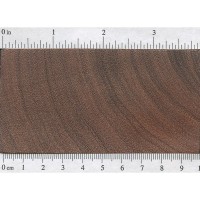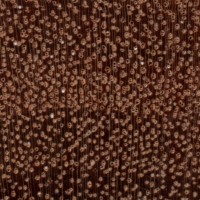 |
Common Name(s): Quina Scientific Name: Myroxylon peruiferum Distribution: Southern Mexico and Central and South America Tree Size: 65-100 ft (20-30 m) tall, 2-3 ft (.6-1.0 m) trunk diameter Average Dried Weight: 58 lbs/ft3 (930 kg/m3) Specific Gravity (Basic, 12% MC): .77, .93 Janka Hardness: 2,200 lbf (9,790 N) Modulus of Rupture: 22,770 lbf/in2 (157.0 MPa) Elastic Modulus: 2,430,000 lbf/in2 (16.76 GPa) Crushing Strength: 12,250 lbf/in2 (84.5 MPa) Shrinkage: Radial: 3.8%, Tangential: 6.2%, Volumetric: 10.0%, T/R Ratio: 1.6 |
Color/Appearance: There is a fair degree of color variation between boards of Quina, ranging from a lighter golden brown to a darker purplish red or burgundy. The color tends to turn more red/purple with age. Quartersawn sections can show a striped or ribbon pattern.
Grain/Texture: Grain is usually interlocked, with a medium to fine texture, and open, medium-sized pores.
Endgrain: Diffuse-porous; medium to large pores in no specific arrangement, few to moderately numerous; commonly in radial multiples of 2-3; reddish brown heartwood deposits common; narrow rays not visible without lens, spacing normal to fairly close; parenchyma vasicentric, lozenge, and confluent.
Rot Resistance: Rated as very durable in regards to decay resistance, with mixed reports on susceptibility to insect attack.
Workability: Quina has a noticeable blunting effect on cutting edges. Working characteristics are rated as fair to poor, on account of both its density and its interlocked grain. Staining or gluing can sometimes be problematic, though the wood finishes well.
Odor: Quina has a very distinctive spicy scent when being worked. Trees from the Myroxylon genus are used to make Balsam of Peru, an ingredient used in perfumes.
Allergies/Toxicity: Although severe reactions are quite uncommon, Quina has been reported to cause skin and respiratory irritation. See the articles Wood Allergies and Toxicity and Wood Dust Safety for more information.
Pricing/Availability: Should be in the mid-range for an imported timber; comparing similarly to other exotic hardwoods used in flooring, such as Ipe.
Sustainability: This wood species is not listed in the CITES Appendices or on the IUCN Red List of Threatened Species.
Common Uses: Flooring, furniture, interior trim, heavy construction, and turned objects.
Comments: Quina is the second of only two species in the Myroxylon genus. Along with Santos Mahogany (Myroxylon balsamum), Quina comprises a special genus of trees commonly referred to as called Balsamo which are used in the production of a substance called Balsam of Peru, used as a fragrance in perfumes.








bottom
I love working with this wood. I have turned 3 bowls and a few spin tops, lots of color and the smell is great and remains even after finishing with carnauba wax. It is also very reactive to a fluorescent light, glows sort of an orange color. Did not have much of a problem with sanding, just slow the lathe down and start with 80g paper (down to 1000g wet with butcher block oil) .
Turned a bowl out of a 6x6x3 block. Very difficult to machine with a lot of tearout of the end grain. Dulled tools very quickly. Once sanded (hard to sand) it finished beautifully.